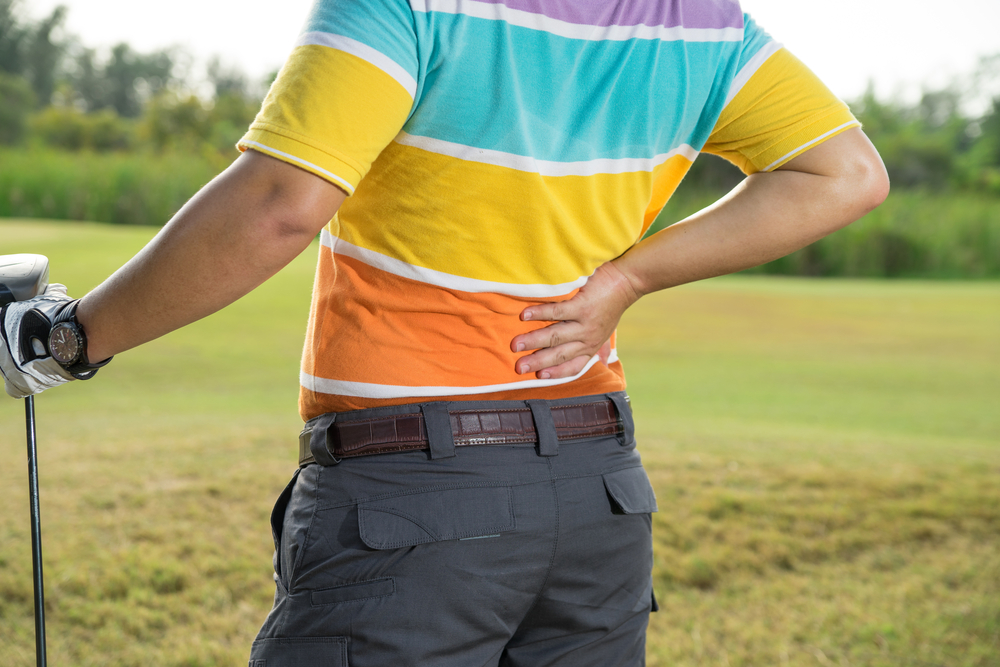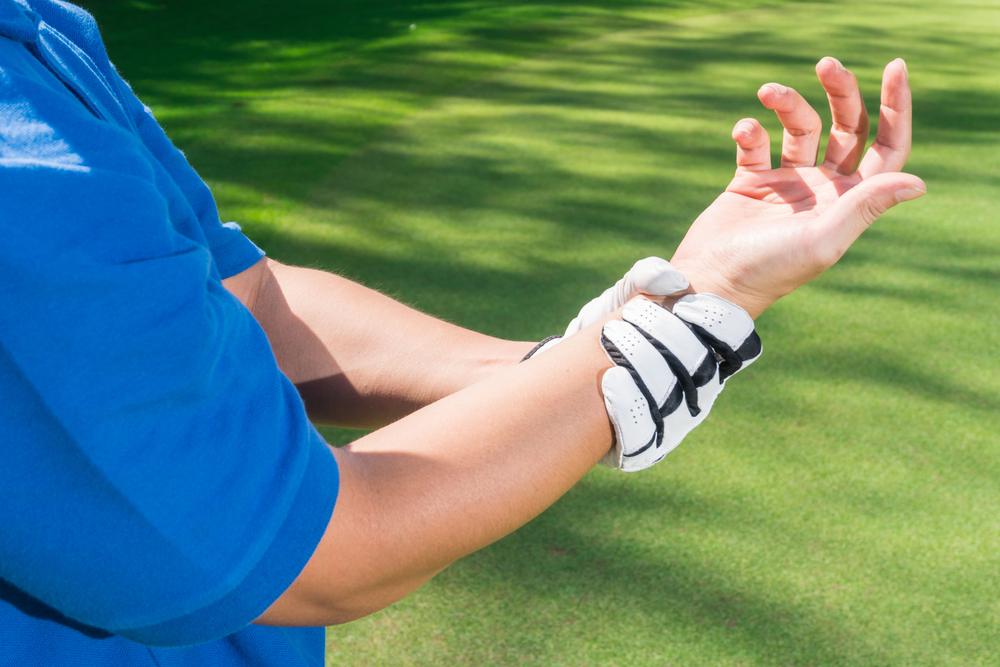
Golf injuries are very real and can follow people around for a long time. If you suddenly jump into the game, take a buddy trip, or trade in your daily work commute for a drive around the links, you may find yourself playing a lot of golf in short period of time. If your body is stiff or your muscles have not experienced this level of activity in a while, bad things can happen if you don't pay attention to your body. Sorry. We didn't make up the law of human biomechanics. We just have play by them.
This is especially true for retirees, for example. All of a sudden you have endless free time to play golf, yet your body may have been inactive for the better part of a few decades (especially if you worked in an office environment). Sure, you’ve played a few rounds of golf each year, but you’ve probably had weeks or months between rounds to rest your body.When you start playing every day at the local golf club, it’s important to take things slowly and build up your body again. Allow it time to adjust to the range of motions involved with every golf swing.
The 5 Most Common Overuse Injuries In Golf
To help give you some awareness, here’s a list of the top 5 most common golf injuries people sustain from overuse. And Coach Joey D will share some thoughts in the video below.
1. Back Pain
While back pain is a broad subject, for golfers, it’s usually the result of having stiff muscles while trying to swing the golf club too fast, limited rotation and lack of body activation. When your muscles are stiff, your range of motion is limited and your body is working against your swing. If you force things to happen, bad results are right around the corner.
The challenge with swinging a golf club is that it’s a rapid, explosive motion. It doesn’t give your muscles a chance to adapt if they’re not already able to perform that range of motion.
Solution: To help prevent back pain while you're out on the course, it’s critical to warm up by stretching your entire body. In our home golf training course, Hit It Great, we show you many dynamic warm-up exercises (that aren’t difficult to perform, even if you’re a beginner or you haven’t played regularly) you can perform at home, or 5 minutes before tee time.
2. Elbow Injuries
Tendonitis is one of the most common elbow injuries in the world (irrespective of activity or job) and is caused by inflamed tendons and ligaments in your elbow. When your outer tendon is inflamed, we call it “tennis elbow.” When it’s your inner tendon, it’s “golfer’s elbow.”
As we get older, our risk of getting tendonitis increases, especially if we’ve been performing activities that require repetitive movements… like hitting golf balls.
Solution: To help reduce the inflammation, give yourself plenty of time to rest. To prevent these injuries from happening in the first place, work on building the muscles around your elbow (forearms, biceps and triceps). Stronger muscles will support your tendons and allow you to enjoy golf for longer periods of time.
3. Knee Pain
Not many people realize how many muscles, ligaments and tendons are used during a single golf swing, particularly in the legs. Your knees play an important role in stabilizing your body and rotating the hips at the beginning of your swing. Because of the explosive movement, extreme force is placed on the knee. If that knee is weak, you run the risk of tearing ligaments.
Solution: While there are many treatment options, you can strengthen your knees by stretching and maintaining a flexible body. Performing the right exercises also helps strengthen your muscles, ligaments and tendons. Recovery is key, too. If your knees are sore after a day of golf, put some ice on them to prevent swelling and inflammation.
4. Rotator Cuff Injuries
If you feel a sharp pain in your shoulder or upper arm while swinging your golf club, you might be flirting with a rotator cuff injury -- check with your doctor. Other common symptoms include experiencing pain during the night and when you extend your arms overhead.
Rotator cuff injuries are often the result of traumatic force. For golf professionals and casual players, it can happen when you poorly execute a golf swing, hit a rock or simply overuse your muscles (especially when you’re not conditioned to play golf daily).
Solution: Common treatments include anti-inflammatory drugs (talk to your doctor) and sometimes surgery. You can help prevent rotator cuff injuries by improving shoulder flexibility and doing golf-specific weight training exercises.
5. Wrist Injuries
As we've seen, swinging a golf club is a repetitive motion. If your body isn’t equipped to handle these repetitive motions injuries are far more likely to occur. 
Your wrists are no exception. The typical high-speed swing places a lot of explosive pressure on your wrists. Pain and tenderness are commonly experienced at the moment of impact and at the top of your backswing.
Solution: Many wrist injuries are a form of tendonitis. Don't neglect them! Use some of our wrist strengthening exercises and give them rest when they need it. If they’re sore, use ice to reduce the swelling.
Pre-Hab Progression For Common Golf Injury Prevention
Whether you’re aiming to become a golf professional or just enjoy looking to enjoy more days on the golf course, (while crushing your opponents) golf requires you to be in good physical condition. This will dictate the level of your success and enjoyment.
Strength training, swing techniques and stretching are all core practices you can perform to improve your Golf Body and prevent injuries. Just keep in mind, not all strength training is good for golf. Some exercises might even HURT your game because they reduce your range of motion (bulky, stiff muscles are no good to a golfer).
Here at the Joey D Golf Fitness Center we’ve developed an entire philosophy surrounding golf fitness and injury prevention.
Join Coach Joey D in short video to learn a few things about helping improve mobility and prevent injury:
Key Takeaways
Poor swing mechanics, weak muscles and stiff tendons are all recipes for injuries. If you’re just getting started with golf, or you suddenly find yourself in a position to play golf multiple times a week, ease into things.
Tempting as it may be, don’t just grab the golf club and start swinging like you’ve been training for years. Perform muscle strengthening exercises at a slow pace. Give your body a chance to adapt to your increased activity level so it can handle the stress caused by swinging a golf club at a high speed.
While there are many different options for treating injuries (always discuss these options with your doctor first), a safe treatment method is R.I.C.E: rest, ice, compression and elevation. It reduces swelling and helps speed up your recovery.
Looking For A Golf Specific Exercise Program You Can Perform At Home?
As we’ve mentioned many times, not all exercises will help improve your golf game. With a combined golf training and coaching experience of over a century, our team here at Joey D Golf Fitness Center have developed the most complete online golf training program.
Every exercise can be easily performed from the comfort of your home (minimal equipment needed) and is designed to turn your body into a golf club swinging machine!
It’s all in video format, so it’s easy to follow along and improve your game.
Let's Get To work!
Team Joey D Golf

